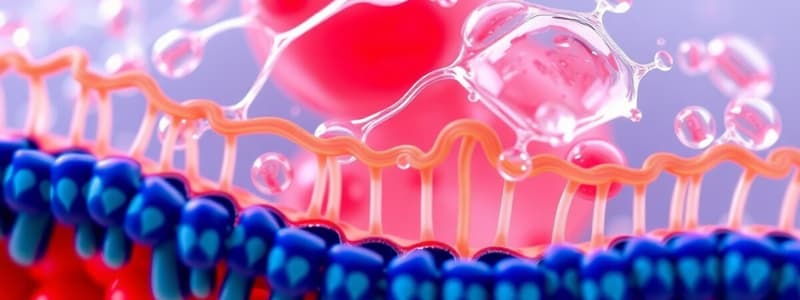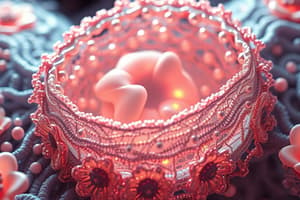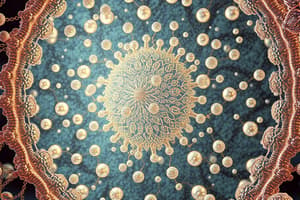Podcast
Questions and Answers
What is the primary role of mitochondria in the cell?
What is the primary role of mitochondria in the cell?
- Cell division
- Protein synthesis
- DNA replication
- ATP production (correct)
Which of the following structures is primarily involved in increasing the surface area of the inner mitochondrial membrane?
Which of the following structures is primarily involved in increasing the surface area of the inner mitochondrial membrane?
- Cristae (correct)
- Porin proteins
- Mitochondrial matrix
- Outer membrane
In mitochondrial dysfunction, which of the following symptoms is commonly observed?
In mitochondrial dysfunction, which of the following symptoms is commonly observed?
- Excessive ATP production
- Muscle weakness (correct)
- Increased protein synthesis
- Liver tissue hyperplasia
What type of inheritance pattern do mitochondrial diseases typically follow?
What type of inheritance pattern do mitochondrial diseases typically follow?
Which component of the mitochondrial structure allows free permeability to molecules?
Which component of the mitochondrial structure allows free permeability to molecules?
What is stored within the mitochondrial matrix that is crucial for various biochemical processes?
What is stored within the mitochondrial matrix that is crucial for various biochemical processes?
What happens to the number of mitochondria in cells with high metabolic activity, like liver cells?
What happens to the number of mitochondria in cells with high metabolic activity, like liver cells?
Which of the following statements is true regarding the structure of mitochondria?
Which of the following statements is true regarding the structure of mitochondria?
Which component of the cell membrane is primarily responsible for providing structural support?
Which component of the cell membrane is primarily responsible for providing structural support?
What is the main function of the glycoproteins and glycolipids in the cell coat?
What is the main function of the glycoproteins and glycolipids in the cell coat?
Which type of transport across the cell membrane does not require energy?
Which type of transport across the cell membrane does not require energy?
Which characteristic distinguishes intrinsic proteins from extrinsic proteins?
Which characteristic distinguishes intrinsic proteins from extrinsic proteins?
What is a key difference between phagocytosis and pinocytosis?
What is a key difference between phagocytosis and pinocytosis?
What is the role of cholesterol within the cell membrane?
What is the role of cholesterol within the cell membrane?
Which of the following processes is involved in the selective import of specific molecules into the cell?
Which of the following processes is involved in the selective import of specific molecules into the cell?
Which type of molecules would most likely pass through the lipid bilayer via simple diffusion?
Which type of molecules would most likely pass through the lipid bilayer via simple diffusion?
Which of the following correctly describes the structural feature of the cell membrane as observed by electron microscopy?
Which of the following correctly describes the structural feature of the cell membrane as observed by electron microscopy?
Which of the following statements about cytoplasmic organelles is accurate?
Which of the following statements about cytoplasmic organelles is accurate?
What is the primary function of the cell membrane?
What is the primary function of the cell membrane?
Which of the following best describes the definition of a cell?
Which of the following best describes the definition of a cell?
What are the smallest and largest types of cells mentioned?
What are the smallest and largest types of cells mentioned?
Which of the following is NOT a characteristic of the cell membrane as stated in the content?
Which of the following is NOT a characteristic of the cell membrane as stated in the content?
Which cytoplasmic organelle is primarily involved in detoxifying substances?
Which cytoplasmic organelle is primarily involved in detoxifying substances?
Which of the following organelles is correctly matched with its function?
Which of the following organelles is correctly matched with its function?
What is a distinguishing feature of MELAS syndrome?
What is a distinguishing feature of MELAS syndrome?
What is a primary function of the Golgi apparatus?
What is a primary function of the Golgi apparatus?
Which clinical finding is NOT associated with MERRF?
Which clinical finding is NOT associated with MERRF?
How does the Golgi apparatus contribute to lysosome formation?
How does the Golgi apparatus contribute to lysosome formation?
What characteristic of Golgi apparatus structure aids in its function?
What characteristic of Golgi apparatus structure aids in its function?
In a case of MELAS, what additional clinical symptom is likely to be present?
In a case of MELAS, what additional clinical symptom is likely to be present?
What type of vesicles carry proteins from the rough endoplasmic reticulum to the Golgi apparatus?
What type of vesicles carry proteins from the rough endoplasmic reticulum to the Golgi apparatus?
Which process is NOT a function of the Golgi apparatus?
Which process is NOT a function of the Golgi apparatus?
Flashcards are hidden until you start studying
Study Notes
Cell Membrane
- The cell membrane is a thin structure that encloses the cellular contents and regulates the transport of substances.
- It is visible by electron microscopy (EM), appearing as two electron-dense lines separated by an electron-lucent intermediate zone.
- The cell membrane is composed of lipids, proteins, and carbohydrates
- Lipids (30%): Phospholipids and cholesterol
- Proteins (60%): Integral and peripheral proteins.
- Carbohydrates (10%): Short chains of polysaccharides that form glycoproteins and glycolipids, contributing to the cell coat.
- The cell coat (glycocalyx) is a layer of glycoproteins and glycolipids on the external surface of the cell membrane.
- Functions of the cell coat:
- Immunological specificity: Contains blood group antigens and acts as a protective mechanical barrier.
- Cell-cell interactions
- Formation of basement membranes
- Functions of the cell membrane
- Protection of cellular integrity
- Regulation of cell-cell interactions
- Recognition of antigens and foreign cells
- Phagocytosis, pinocytosis, and exocytosis
- Controlling movement of substances in and out of the cell (selective permeability)
Transport of Materials through Cell Membrane
- Passive transport: Simple diffusion and facilitated diffusion
- Active transport: Requires energy (e.g., Na+/K+ pump)
- Bulk transport:
- Endocytosis: Movement of substances into a cell
- Phagocytosis: Engulfment of solid particles.
- Pinocytosis: Engulfment of liquids.
- Receptor-mediated endocytosis: Highly selective process that requires specific receptors.
- Endocytic vesicles become associated with clathrin proteins.
- Exocytosis: Movement of substances out of a cell
- Extrusion of residual bodies
- Endocytosis: Movement of substances into a cell
Mitochondria
- The mitochondria are responsible for energy (ATP) production.
- They are enclosed by two membranes: an outer smooth membrane and an inner membrane that folds into cristae.
- The inner membrane contains respiratory chain enzymes and ATP synthase.
- The mitochondrial matrix is rich in oxidative enzymes and dense granules that store calcium.
- Mitochondria can move and divide independently, as they contain their own DNA, ribosomes, and systems for protein synthesis.
- Mitochondria are more abundant in cells with high metabolic activity, such as liver cells.
Medical Application of Mitochondria
- Abnormal mitochondrial DNA can lead to failure of oxidative metabolism, impairing mitochondrial function.
- Most common patterns of mitochondrial disorders:
- Muscle weakness (mitochondrial myopathy)
- Degenerative central nervous system disease (e.g., loss of optic nerve fibers, cerebellar tissue, white matter)
- Metabolic disturbances (e.g., lactic acidosis)
- Mitochondrial diseases are maternally inherited and can manifest at any age.
- Diagnosis can be assisted by muscle biopsy and analysis of mitochondrial DNA.
Subtypes of Mitochondrial Myopathies
- MELAS: Mitochondrial encephalomyopathy, lactic acidosis, recurring stroke-like episodes
- Other findings include muscle weakness, seizures.
- MERRF: Myoclonic epilepsy with ragged red fibers; destruction of proteins involved in oxidative phosphorylation
- Other findings include generalized seizures.
Golgi Apparatus
- Found between the nucleus and the cell periphery.
- The secretory apparatus of the cell.
- Structure by light microscopy (LM):
- Negative Golgi images: Intensely basophilic cells (e.g., plasma cells)
- Special techniques (e.g., silver stain) reveal darkly staining granules and fibrils
- Structure by EM:
- Flattened vesicles: Elongated, parallel sacs piled upon the other, forming stacks.
- Cis (forming, immature) face: Faces the cell base
- Trans (mature) face: Faces the cell surface.
- Transfer vesicles (microvesicles): Carry proteins from rough endoplasmic reticulum (rER) to the cis face of the Golgi apparatus.
- Macrovesicles (condensing vacuoles): Large, distended vesicles that separate from the trans face of the Golgi apparatus and mature into secretory vesicles or secretory granules.
- Flattened vesicles: Elongated, parallel sacs piled upon the other, forming stacks.
Functions of the Golgi Apparatus
- Packaging and storage of proteins.
- Modification of proteins: Adding carbohydrates, glycogen, or phosphate groups.
- Formation of secretory proteins.
- Renewal of the cell membrane.
- Formation of lysosomes.
Case Scenario
- A 32-year-old woman presents with recurrent generalized seizures, diffuse muscular weakness, and episodes of transient left-sided paresis.
- This clinical presentation suggests a mitochondrial disorder, possibly MELAS or MERRF.
- Genetic consultation is essential to confirm the diagnosis and provide guidance for management.
Studying That Suits You
Use AI to generate personalized quizzes and flashcards to suit your learning preferences.




